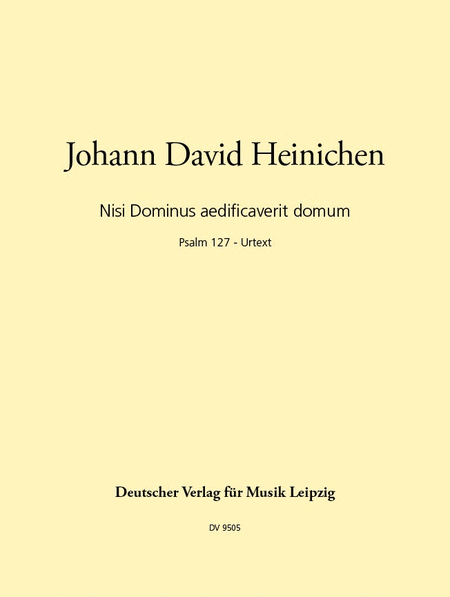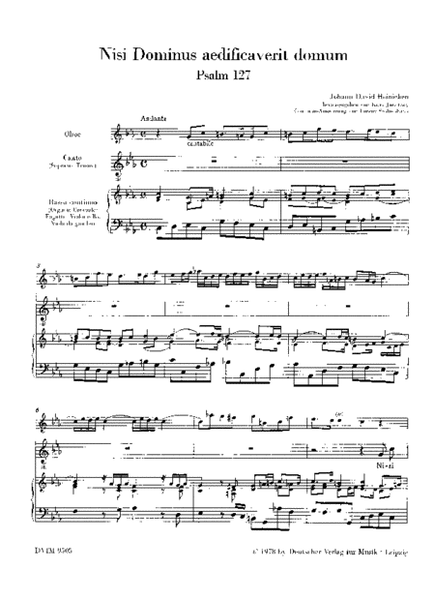Nisi Dominus aedificaverit domum
Psalm 127 - Urtext
Details
Description
SKU: BR.DV-9505
Psalm 127 - Urtext. Composed by Johann David Heinichen. Voice; Softcover. Deutscher Verlag. Psalm; Baroque. Score. 24 pages. Deutscher Verlag fur Musik #DV 9505. Published by Deutscher Verlag fur Musik (BR.DV-9505).ISBN 9790200490565. 9 x 12 inches.
Johann David Heinichen was born on 17 April 1683 in Krossuln near Teuchern, in the vicinity of Weissenfels. He sang as a boy chorister under Johann Schelle and Johann Kuhnau at Leipzig's St. Thomas church. He studied first in W eissenfels, then in Leipzig, Naumburg, Zeitz, Rome, Florence and Venice. Even before he completed his studies, the ambitious and talentcd young man gained high regard among his colleagues as "the first authority on matters of general hass" His agreeable "turn of mind and stylistic taste" led him to brilliantly carry out many a commission - particularly cantatas and serenades - and to be appointed in 1717 as Royal Polish and Eleetoral Saxon "Maitre de chapelle" at the court of August the Strong in Dresden. In his theoretical works, he passed on his experience to a younger generation of musicians, and thanks to his talent for discovering gifted singers and obtaining their services for Dresden, he carned himself a reputation as a highly admired "pied pipcr of lovely voices". His creations as "compositeur" and his activity as a "Capell-Meister" responsible for the wide variety of music perforrned at the many courtly festivities of one of the most magnificent and art-loving European courts were admired and valued by the greatest minds of the time. Even Johann Sebastian Bach regarded several of Heinichen's chamber works so highly that he copied them in his own hand for his personal use. Music history has assigned hirn the place of honor which he deserves in the brilliant row of Saxon court Kapellmeisters between his famous predecessors Johann Walter and Heinrich Schutz, and his successors Johann Adolf Hasse and Carl Maria von Weber. Heinichen died of "consumption" in Dresden's Schossergasse on 16 July 1729. Stylistically, Heinichen's highly divcrsified oeuvre coincides perfectly with the particular mentality of the Baroque era. As a typical exponent of the "mixed taste", he masterfully filled the elegant but often rather insipid songfulness of the prevailing Italian style with "galant" expressiveness and raised its level of intensity with deep and genuinely felt emotion. The psalm text of the solo motet Nisi Dominus aedificaverit domum was widely popular and used in a variety of settings. In his C-minor setting of 1723, Heinichen enhanced the text with a formally well-rounded composition full of delightful sonorities, yet utterly faithful to its serious intent. Contrary to his setting of the same text in G minor (probably earlier, and completely autonomous) for soprano, bass, obbligato oboe and small orchestra, Heinichen expressly leaves the choice of the soloist - either soprano or tenor - to the performers, and adds a chamber-style concertante oboe to the inevitable general bass. Following the practice of the time, it is perfectly plausible to replace the oboe with a flute or violin. The likeliest continuo instrument is the organ or portative. However, a "chamber" registration would also suit the piece even in a !arger hall. When using a harpsichord, one should be aware that longer notes in the continuo realization are to be broken down into shorter note values. Tbe execution depends on the continuo player's taste and habits, particularly since the printed realization should only be considered as a one of many possible ways of interpreting the continuo. lt should not stifle or suppress the element of improvisation. The ornaments offer a broad domain for spontaneous music-making. This edition, which offers the editor's suggested realizations of only the most important embellishments, gives the performer a wide scope to introduce ornaments according to bis stylistic understanding and technical proficiency. Of course, it should be warned against burdening the melody with too many ornaments, or against executing the piece all too soberly and dryly. lt is essential to have an appropriate bass instrument (bassoon, violoncello, viola da gamba) even when there is an organ with strong bass registers on hand. The continuo realization has been prepared according to the guidelines given by Heinichen himself in his Der General-Bass in der Composition (1728). Kurt Janetzky, Leipzig, Summer 1972.


 Share
Share